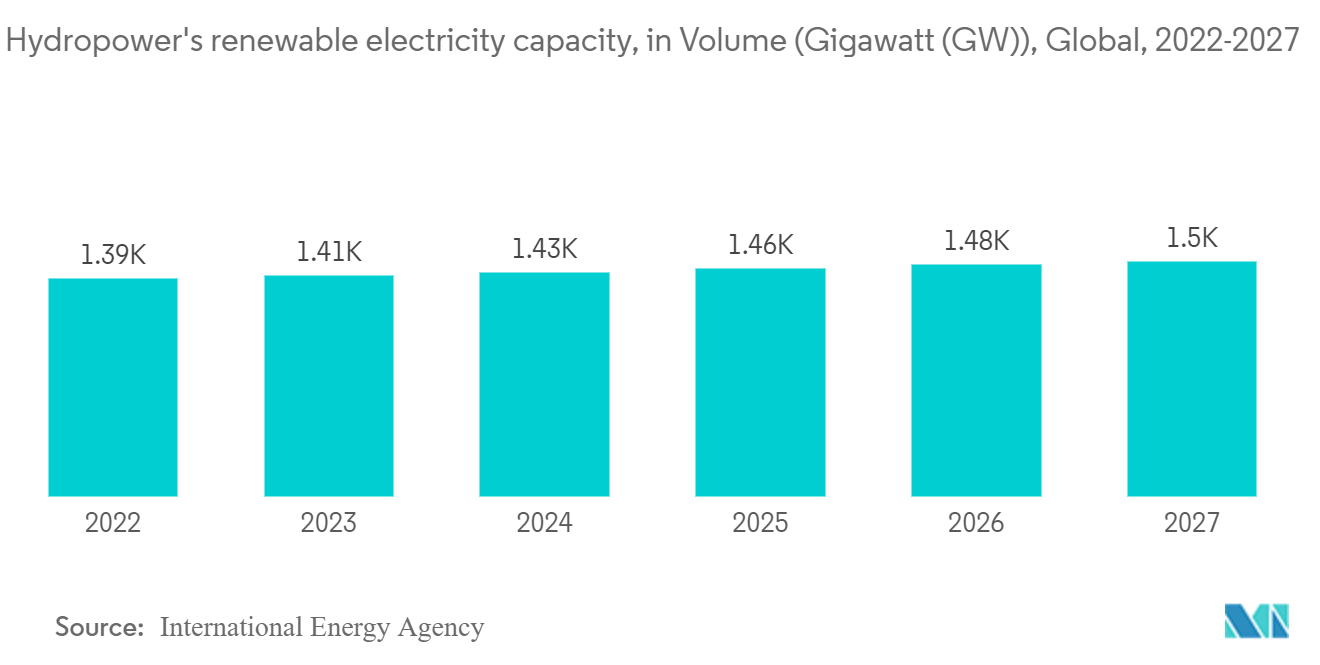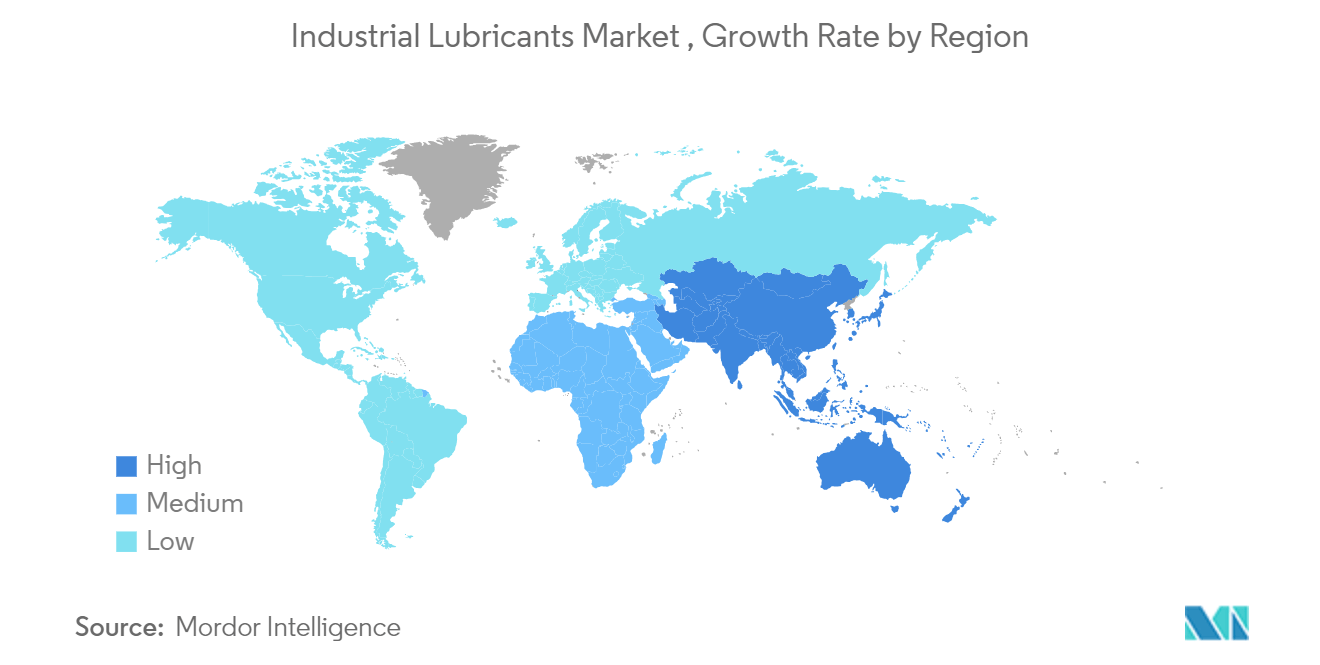Market Trends of Industrial Lubricants Industry
Power Generation End-user Industry Dominated the Market
- Power generation is one of the most important end-user industries of the global economy, without which almost all manufacturing operations may cease. Advancements in manufacturing technologies are resulting in the building of various new plants, increasing the demand for electricity across end-user industries.
- Turbines play a key role in the energy sector for generating electricity. Irrespective of the source of electricity, i.e., wind, solar, hydro, thermal, and others, turbines are widely used for power generation. In general, other than turbines, the major components used in the power generation sector include pumps, bearings, fans, compressors, gears, and hydraulic systems. Wind turbines are subjected to many factors, such as humidity, high pressure, high loads, vibrations, and temperature. Gear and turbine oils are widely used in this sector for lubrication purposes.
- In general, the cost of lubricants accounts for less than 5% of a power generation company's total operational expenditure. According to an industry survey, about 58% of the companies recognized that lubricant selection could help reduce costs by 5% or more. Still, fewer than 1 in 10 (8%) companies realized that the impact of lubrication could be up to six times more.
- In hydroelectric power generation, lubricants are used for air compressors, gears, turbines, circulating oil systems, hydraulics, and bearings, among other purposes. The lubricants consumed include greases, general lubricating oils, transmission oils, turbine oils, and hydraulic oils, among others. In nuclear power plants, lubricants (turbine oils) are used mainly for steam turbines for better efficiency.
- In coal-fired power plants, lubricants are used for air compressors, hydraulics, turbines, mobile equipment, bearings, and gears. Coal excavator systems also consume different types of lubricants, including gear oils, greases, transmission oils, and hydraulic oils. Coal-fired power plants consume high-temperature and heavy-duty lubricants.
- Moreover, according to the International Energy Agency, in 2023, the volume of renewable electricity generated globally through hydropower and wind increased by about 17.5 gigawatts (GW) and 107.8 gigawatts (GW), respectively, over 2022. Such growth trends are expected to continue during the forecast period because of the growing investment in renewable energy generation. It will substantially boost the demand for industrial lubricants from the power generation end-user industry in the future and help it maintain its market dominance.
- Hence, all such factors and trends are expected to drive the demand for lubricants in the power generation end-user industry.

Asia-Pacific Region to Dominate the Market
- Asia-Pacific was found to be the major market for the consumption of industrial lubricants. It is owing to increasing consumption from countries such as China, India, and Indonesia.
- China is the largest consumer of lubricants and greases in the current scenario. The vast manufacturing activities pertaining to different sectors and the rapid growth in the industrial and automotive sectors pushed the country to stand among the major lubricant consumers and producers in the global landscape.
- Moreover, according to Safeguard Global, China, Japan, South Korea, India, and Indonesia were among the top 10 countries with the highest manufacturing output in 2023.
- In addition, China is focusing on new infrastructure, with construction being the majority type of fixed assets, in the near future. Such growth in construction activity is expected to be witnessed in the future, owing to increased expenditure and the government's focus on infrastructure growth.
- According to the International Organization of Motor Vehicle Manufacturers (OICA), China, Japan, India, and South Korea were among the top 5 largest manufacturers of vehicles in the world. Therefore, the vast size of Asia-Pacific's automotive industry also plays a significant role in the region accounting for such high demand for industrial lubricants compared to other regions worldwide.
- Moreover, according to Invest India, the auto components industry in India is expected to grow to USD 200 billion by 2026, and the aftermarket turnover in FY 2022-23 of the industry stood at USD 10.6 billion as compared to USD 10 billion in the previous year. Such growth trends in India and developing economies of the Asia-Pacific are estimated to significantly boost the industrial lubricants market growth in the region.
- India is the second-largest lubricant consumer in the region and the third-largest in the world, after the United States and China. The country accounts for about 7% of the demand in the global lubricants market. While the industrial lubricants market is fragmented in nature, the Indian grease market is highly consolidated in nature, with the top five players accounting for more than 75% of the market share.
- Favorable government policies, such as the extension of the FAME-II scheme until 2024, the enhancement of incentives for two-wheelers, the launch of the production-linked incentive (PLI) scheme for the auto and auto component sector (worth INR 26,000 crore (~USD 3.20 billion)), and the PLI for advanced chemistry cell worth INR 18,000 crore (~USD 2.22 trillion), are likely to provide significant support to the sector due to the adoption of advanced technologies.
- Indonesia is among the potential lubricants markets in recent years on account of its huge population, high urbanization, and rapidly rising middle class. Sectors such as mining, textile, and infrastructure is driving the consumption of industrial lubricants in the recent past.
- According to FocusEconomics, in 2022, manufacturing growth in Indonesia was 4.9%, up from the 3.4% witnessed in the prior year. Moreover, according to Statistics Indonesia (BPS), the food and beverage industry increased by 4.9% on an annual basis in 2022 to USD 52.1 million as the demand and production increased.
- Indonesia is expected to invest and attract foreign direct investment across industries to boost its exports and, thus, its economic state. Additionally, the country started working with Taiwan to develop its food and beverage industry because Taiwan is quite developed in the field of automated food machine technology and catering services.
- Therefore, all the factors above are likely to significantly impact the market studied in the future.


